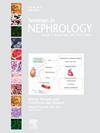求助PDF
{"title":"Gene-Environment Interaction: Lessons From Complement-Mediated Kidney Disease.","authors":"Nattawat Klomjit, Jing Miao, Anuja Java","doi":"10.1016/j.semnephrol.2025.151657","DOIUrl":null,"url":null,"abstract":"<p><p>Atypical hemolytic uremic syndrome (aHUS) or complement-mediated thrombotic microangiopathy (CM-TMA) and C3 glomerulopathy are two prototypical diseases of complement dysregulation occurring due to genetic variants in complement proteins or acquired factors such as autoantibodies. Despite the presence of an underlying genetic etiology, an environmental trigger is often necessary to manifest disease, a phenomenon known as incomplete penetrance. These triggers could include infections, pregnancy, medication, cancers, or ischemia-reperfusion injury and antibody-mediated rejection in the setting of transplantation and highlight the complex interplay between genetic etiology and environmental factors. Other diseases in which complement activation may also be a part of the underlying pathophysiology and where the gene-environment interaction also plays out are IgA nephropathy, lupus nephritis, ANCA-associated vasculitis, and membranous nephropathy. Genetic polymorphisms and haplotypes may further skew the balance between complement over activation and control. In this article, we discuss the activation and regulation of the complement system and the role of complement in various kidney diseases. We also attempt to provide an in-depth understanding of the genetic drivers and environmental triggers associated with complement activation using aHUS as a key example. Semin Nephrol 36:x-xx © 20XX Elsevier Inc. All rights reserved.</p>","PeriodicalId":21756,"journal":{"name":"Seminars in nephrology","volume":" ","pages":"151657"},"PeriodicalIF":3.5000,"publicationDate":"2025-07-01","publicationTypes":"Journal Article","fieldsOfStudy":null,"isOpenAccess":false,"openAccessPdf":"","citationCount":"0","resultStr":null,"platform":"Semanticscholar","paperid":null,"PeriodicalName":"Seminars in nephrology","FirstCategoryId":"3","ListUrlMain":"https://doi.org/10.1016/j.semnephrol.2025.151657","RegionNum":3,"RegionCategory":"医学","ArticlePicture":[],"TitleCN":null,"AbstractTextCN":null,"PMCID":null,"EPubDate":"2025/7/16 0:00:00","PubModel":"Epub","JCR":"Q2","JCRName":"UROLOGY & NEPHROLOGY","Score":null,"Total":0}
引用次数: 0
引用
批量引用
Abstract
Atypical hemolytic uremic syndrome (aHUS) or complement-mediated thrombotic microangiopathy (CM-TMA) and C3 glomerulopathy are two prototypical diseases of complement dysregulation occurring due to genetic variants in complement proteins or acquired factors such as autoantibodies. Despite the presence of an underlying genetic etiology, an environmental trigger is often necessary to manifest disease, a phenomenon known as incomplete penetrance. These triggers could include infections, pregnancy, medication, cancers, or ischemia-reperfusion injury and antibody-mediated rejection in the setting of transplantation and highlight the complex interplay between genetic etiology and environmental factors. Other diseases in which complement activation may also be a part of the underlying pathophysiology and where the gene-environment interaction also plays out are IgA nephropathy, lupus nephritis, ANCA-associated vasculitis, and membranous nephropathy. Genetic polymorphisms and haplotypes may further skew the balance between complement over activation and control. In this article, we discuss the activation and regulation of the complement system and the role of complement in various kidney diseases. We also attempt to provide an in-depth understanding of the genetic drivers and environmental triggers associated with complement activation using aHUS as a key example. Semin Nephrol 36:x-xx © 20XX Elsevier Inc. All rights reserved.
基因-环境相互作用:补体介导肾病的经验教训。
非典型溶血性尿毒症综合征(aHUS)或补体介导的血栓性微血管病(CM-TMA)和C3肾小球病是补体失调的两种典型疾病,由于补体蛋白的遗传变异或获得性因素(如自身抗体)而发生。尽管存在潜在的遗传病因,但环境触发往往是表现疾病所必需的,这种现象被称为不完全外显。这些触发因素可能包括感染、妊娠、药物、癌症、缺血再灌注损伤和移植环境中抗体介导的排斥反应,并强调遗传病因和环境因素之间复杂的相互作用。补体激活也可能是潜在病理生理的一部分,基因-环境相互作用也发挥作用的其他疾病包括IgA肾病、狼疮肾炎、anca相关血管炎和膜性肾病。遗传多态性和单倍型可能进一步扭曲补体过度激活和控制之间的平衡。在本文中,我们讨论了补体系统的激活和调节以及补体在各种肾脏疾病中的作用。我们还试图以aHUS为例,深入了解与补体激活相关的遗传驱动因素和环境触发因素。Semin Nephrol 36:x-xx©20XX Elsevier Inc.。版权所有。
本文章由计算机程序翻译,如有差异,请以英文原文为准。

 求助内容:
求助内容: 应助结果提醒方式:
应助结果提醒方式:


